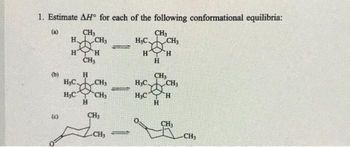
Organic Chemistry
9th Edition
ISBN: 9781305080485
Author: John E. McMurry
Publisher: Cengage Learning
expand_more
expand_more
format_list_bulleted
Concept explainers
Question

Transcribed Image Text:1. Estimate AH° for each of the following conformational equilibria:
(a)
CH3
H CH3
Ø
H H
CH₂
H
(b)
(c)
H₂C
CH₂
H₂C CH3
H
CH₂
-CH₂
=
-
H₂C.
H
CH3
H
CH₂
H
CH3
H₂C CH₂
Q
HỌC TH
H
пенсия
CH₂
Expert Solution
This question has been solved!
Explore an expertly crafted, step-by-step solution for a thorough understanding of key concepts.
This is a popular solution
Trending nowThis is a popular solution!
Step by stepSolved in 4 steps with 3 images

Knowledge Booster
Learn more about
Need a deep-dive on the concept behind this application? Look no further. Learn more about this topic, chemistry and related others by exploring similar questions and additional content below.Similar questions
- CH3 to Br- -H + Nal • product; Sy2 product of the reaction is : Аcetone H- -CH3 CH2 – CH3 CH3 CH3 CH3 CH3 it it -H H- -CH3 (d) -CH3 -H- (а) H• (Ъ) H- -CH3 -CH3 (с) H- CH -H- ČH2 – CH3 ČH2 – CH3 CH2 – CH3 CH2- CH3 2.arrow_forwardH-C- OH Does the equilibrium lie to the left or to the right in the following reaction: Н-С—ОН + CH,-Ö:- ċ-0 + CH,-ö-H ??arrow_forwardPQ-23. At 298 K, the equilibrium constant for this reaction H2(g) + O2(g)= H₂O(l) AG° (kJ mol¹) -237 -229 H₂O(1) H₂O(g) (A) has a value of 1.0 at equilibrium. (B) is larger than the Keq for H2(g) + O2(g)=H₂O(g). (C) cannot be computed since data on O2 and H2 are not provided. (D) will have the same value as the Keq for H2(g) + O2(g)= H₂O(g)arrow_forward
- The AH° values of each compound is given below as kJ/mol. Calculate the entaphy change (AH) value of the following reacti on? 2CaOg) + 2SO2 (g + Ozg) →2 CasO41) -635.5 -296.9 0.0 -1432.7 (kJ/mol) A) 500.3 kJ B) -500.3 kJ С) -1000.6 kJ D) 2365.1 kJ E) -1094.1 kJarrow_forward(a) (b) HO N N-H Catalytic H+ (-H₂O) ? (c) NH2 HO N (d)arrow_forwardNaming Alkenes 7-37 Name the following alkenes: (a) CH3 (b) CH3 CH2CH3 (c) CH2CH3 CH3CHCH2CH,CH CH3 H2C=CCH2CH3 CHCH2CH3 C=C H C=C H3C H3C H. H (f) H2C=C=CHCH3 (е) CH3 C=C (d) H H3C C=C CH3 C=C CH3 H3C H. H2C=CHCHCH CH3CH2CH2 CH3arrow_forward
- a) Which curve (i, ii, iii, iv or v) corresponds to F2 → 2F- b) Which curve (i, ii, iii, iv or v) corresponds to Cl2 → 2C1- c) Which curve (i, ii, iii, iv or v) corresponds to Br2 → 2Br. d) Which curve (i, ii, iii, iv or v) corresponds to 12 → 21. e) Which curve (i, il, iii, iv or v) corresponds to CH3CH2-H f) The sign of H° for all of these steps is: Opositive Onegative -> Potential Energy Bond Dissocation Energy (BDE): the energy needed to break a bond homolytically (energy input: H>0, a positive energy value) the energy released in forming a bond (energy output: H 0, a negative energy value) → CH3CH2 + H. شکر Reaction coordinate ivarrow_forwardPlease don't use hend raitingarrow_forwardNonearrow_forward
- Give systematic IUPAC names for each of the following: (b) ty C (d) Br s ㅎ OH (1) Br Br (h) CI &arrow_forward10arrow_forward5-52 The following syntheses have flaws in them. What is wrong with each? (a) .CH3 .CO2H 1. Cl2, FeCl3 2. KMNO4 CI (b) CІ CI. 1. (CH3)3CCI, AICI3 2. KMNO4, H2O CO2Harrow_forward
arrow_back_ios
SEE MORE QUESTIONS
arrow_forward_ios
Recommended textbooks for you
